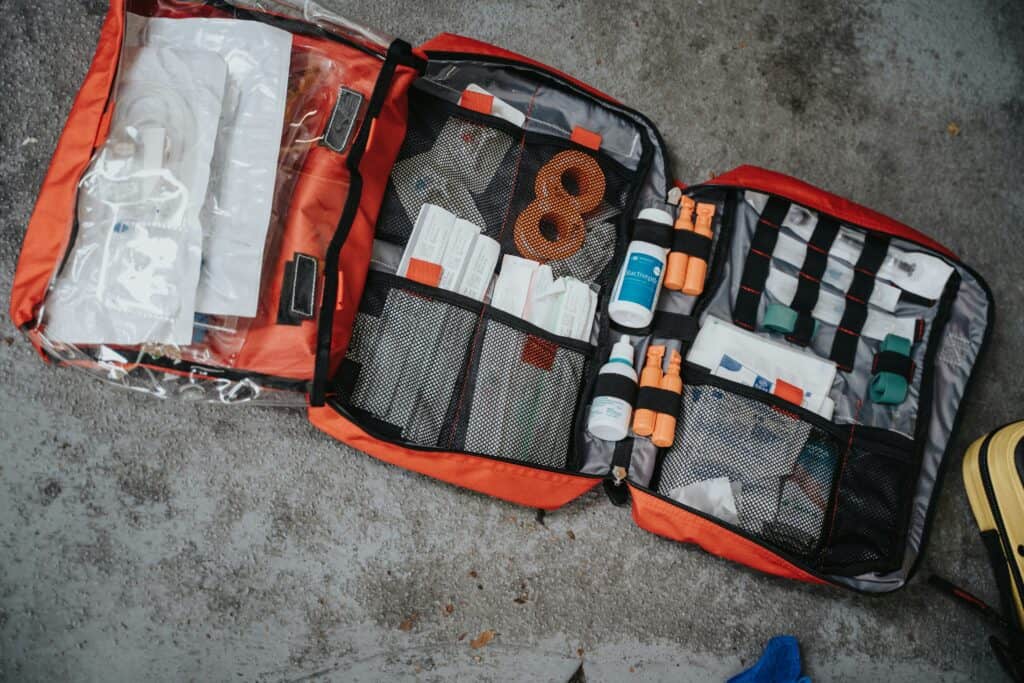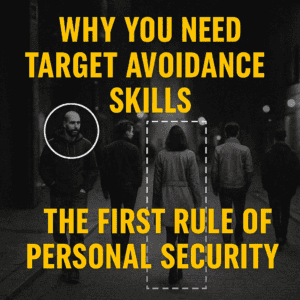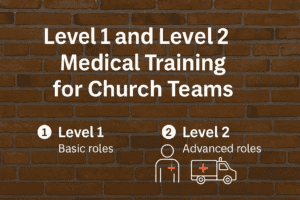Church safety and security has become an increasingly important topic in recent years, as congregations look to protect their members and assets from potential threats. Implementing and maintaining church safety and security policies and procedures is essential for fostering a secure environment and ensuring the well-being of those who attend services and other events.
The foundation of any effective church safety program begins with establishing a clear vision and mission statement for a security team. This will outline the team’s objectives and expectations, enabling members to understand their roles and responsibilities. To facilitate effective communication practices, both internally and externally, it’s crucial to have guidelines in place for selecting security team members, based on skills, background checks, and relevant experience.
Ongoing training is a key component for security team members, which may include topics such as hands-on firearms competency, de-escalation practices, and various scenario-driven exercises. Additionally, cultivating partnerships with local law enforcement is critical to ensure a cohesive response in the event of an emergency.
To further enhance security at the church, it’s vital to educate staff and congregation members on awareness communication and the appropriate actions to take during different situations. Addressing concealed carry holders who are not part of the security team should also be part of the policies and procedures, ensuring that everyone knows their role in maintaining a safe and secure environment for all.
Security Team Vision and Mission Statement
The vision and mission statement for a church security team should encompass the main goals and objectives the team aims to achieve. The ideal security team aspires to create a safe and secure environment for all church members, staff, and visitors while maintaining a welcoming atmosphere.
The church safety and security team’s vision should include promoting a sense of preparedness and awareness among the congregation. This involves cultivating confidence in the team’s ability to handle potential threats or emergencies and fostering a culture where everyone feels empowered to contribute to the safety and security of the church community.
The mission statement for the security team should encompass core duties and responsibilities, which include vigilance, discretion, and professionalism. The primary objective is to protect the congregation and minimize any potential risks or hazards. This can be achieved by collaborating closely with local law enforcement agencies, investing in relevant training, and consistently staying informed about emerging trends and best practices in church safety and security.
Creating a comprehensive security plan involves outlining clear guidelines for team members’ roles and responsibilities. It is essential to have a methodical recruitment process, considering factors such as professional background, experience, and personal character. Once chosen, the security team must maintain clear communication both internally between team members and externally with the church staff and congregation.
Regular training sessions should be conducted to reinforce the team’s expertise in various safety and security scenarios. Topics such as firearm competency, shoot/don’t shoot scenarios, rules of engagement, de-escalation practices, and tabletop exercises are crucial components of a well-rounded safety and security program. Mock drills can serve as valuable hands-on training opportunities to help the team stay prepared for real-life emergencies.
It is essential to maintain an open and constructive relationship with local law enforcement and to keep the congregation informed about potential risks, safety guidelines, and appropriate actions during different situations. Additionally, having a clear policy on how to address concealed carry holders who are not part of the security team ensures that safety remains the top priority and reduces the likelihood of confusion or misunderstanding during an emergency.
Core Team Objectives and Expectations
The main objective of the security team is to ensure the safety and security of all church members, staff, and visitors, while maintaining a welcoming and peaceful environment. This involves prioritizing the well-being of the congregation and demonstrating a strong commitment to their protection.
Team members are expected to have a clear understanding of their responsibilities, which include responding to emergencies, monitoring suspicious activities, and preventing potential security threats. To achieve this, they must be well-trained in various security-related topics, including firearms competency, shoot/don’t shoot scenarios, rules of engagement, and de-escalation practices. Regular hands-on training and mock drills should be conducted to stay prepared for unexpected situations.
Effective communication is essential for the smooth functioning of the security team. Internally, team members should collaborate and share information to ensure a coordinated response to any situation. Externally, they must be able to communicate with local law enforcement and other relevant organizations to keep them informed about any potential threats or concerns.
Supporting partnerships with local law enforcement agencies allows for better coordination and support in times of crisis. These partnerships also help establish clear expectations for the security team and staff during emergency situations.
The church should also provide necessary safety and awareness training for all its members and staff. This would enable them to better handle different situations and improve the overall security of the space.
Regarding concealed carry holders who are not part of the security team, the church should establish guidelines and procedures for addressing them. This may include informing them about the presence of the security team and providing instructions on what to do in case of an emergency.
In conclusion, the core team objectives and expectations revolve around maintaining a safe and secure environment for everyone at the church. By prioritizing the well-being of the congregation, staying well-trained and committed, and fostering open communication, the security team can provide protection and peace of mind for all attendees.
Security Team Policies and Procedures
The security team’s vision and mission statement should emphasize the importance of providing a safe and secure environment for all church attendees. This entails clear objectives and expectations for every team member to ensure the adequate protection of church property and members.
When considering the recruitment guidelines and role descriptions of security team members, focus on the required skills, experience, and ability to handle various situations. Background checks and vetting processes should be implemented to ensure members are suitable for their roles.
Internal and external communication practices are vital for the security team to operate efficiently. Establishing protocols, such as a chain of command, will keep everyone informed and enable quick responses during emergencies. Regular security updates and collaboration with church staff will also contribute to the awareness of potential threats.
To maintain a high level of preparedness, security team members should undergo regular training, including:
- Firearms competency
- De-escalation practices
- Shoot-don’t shoot scenarios
- Rules of engagement
- Tabletop scenarios
- Mock drills
Collaboration with local law enforcement and external security consultants can enhance the effectiveness of security strategies and training.
In addition, staff and church members should receive training on safety awareness and necessary actions during emergencies. Communication methods such as posters, emails, or announcements can be utilized to convey safety information to the community.
Lastly, it is essential to address the presence of concealed carry holders that are not part of the security team. Establishing a policy on the allowable use of firearms by non-security members within church premises, as well as guidelines on cooperation between the security team and concealed carry holders, will help maintain order and safety during emergencies.
In conclusion, properly defined policies and procedures, along with regular training and communication, can contribute to a secure church environment and ensure the safety of all attendees.
Job Description and Responsibilities
Guidelines and Background Checks
When recruiting security team members for a church, it is crucial to follow strict guidelines to ensure the safety and security of the congregation. A thorough background check is essential to verify the candidate’s history and to identify any potential red flags. Background checks typically include a review of criminal records, employment history, and personal references. Additionally, prospective members should fill out an application that provides further information about their qualifications and experience.
Duties and Tasks
Church security team members are responsible for various tasks to ensure the safety of the congregation and the church property. Some of their duties include:
- Patrolling and monitoring the church premises to identify and address any potential security risks or threats
- Responding to incidents and emergencies, such as medical situations, disturbances, or unauthorized access
- Following established safety and security policies and procedures to maintain a safe environment for all churchgoers
- Collaborating with local law enforcement agencies and maintaining open lines of communication to enhance safety measures
Security personnel must also stay up-to-date on training topics and frequently engage in hands-on training exercises. They should be proficient in firearms competency, understand the rules of engagement, and participate in shoot/don’t shoot scenarios. De-escalation practices and tabletop scenarios should also be regularly incorporated into their training regimen. All team members are expected to take part in mock drills to ensure preparedness during various emergency situations.
Furthermore, security team members should be knowledgeable about how to address concealed carry holders who are not part of the team and communicate effectively with both internal staff and external partners. They must also provide awareness communication and advise the rest of the staff or members of the organization on potential safety and security threats. In essence, church security team members play a crucial role in maintaining a secure and confident environment for everyone in the institution.
Security Team Communication Practices
Internal Communication
Effective internal communication within the security team is crucial for church safety and security. Team members should have a clear understanding of their roles and responsibilities, as well as the expectations set forth by the church leadership. Regular team meetings should be held to discuss security-related issues and updates, address any concerns, and to maintain a cohesive team dynamic. A variety of communication channels, such as direct messaging via a secure app or closed email group can be utilized to keep everyone on the same page.
External Communication
Security team communication with the larger church community is essential for fostering a safe environment and creating a sense of involvement. This can be done through the church’s website, social media platforms, and announcements to inform members of the congregation about safety protocols and expectations.
Collaboration with local law enforcement is a vital aspect of external communication. Partnering with these entities strengthens church security and assists in providing comprehensive training sessions, including hands-on training, shoot/don’t shoot scenarios, and de-escalation practices. Coordination with local authorities allows for efficient response in emergency situations.
Addressing concealed carry holders who are not part of the security team requires a clear policy and communication with the congregation. Church leaders should outline guidelines related to concealed carry, including where firearms are permitted and under what circumstances. Communication with concealed carry holders can be facilitated through signage, announcements, and the church’s website.
Partnerships and Collaborations

Local Law Enforcement
Partnerships with local law enforcement play a crucial role in maintaining the security of a church. Building a strong relationship with the police not only enables better communication but also provides access to valuable resources and training opportunities.
For example, police may offer suggestions on how to improve security measures on the church premises or provide regular updates on potential threats in the community. Regular meetings and collaboration with local law enforcement help ensure the church security team has up-to-date knowledge and resources to deal with different safety scenarios.
Church Staff and Volunteers
Engaging church staff and volunteers in security efforts is vital for a comprehensive security plan. By training staff members and volunteers on various safety procedures, the entire church community becomes more vigilant and prepared for potential threats. For instance, staff and volunteers could participate in tabletop scenarios, mock drills, and de-escalation practices, enabling them to acquire the skills necessary for handling a security incident.
The involvement of staff and volunteers in the security team also paves the way for effective communication. This ensures that all parties are aware of protocols and can respond efficiently in emergency situations. Additionally, training sessions on awareness communication equip staff and volunteers with knowledge on how to handle concealed carry holders who are not part of the team.
Implementing well-rounded security policies and procedures requires strong partnerships and collaborations between the church’s security team, local law enforcement, and the community itself. By working together, these entities can create a safer environment for worship and fellowship.
Security Team Training
Church safety and security teams must undergo regular and comprehensive training to effectively protect the congregation. Key areas for training include firearms competency and de-escalation techniques, scenario-based exercises, and mock drills.
Firearms Competency and De-escalation
Security team members need to be trained in handling firearms responsibly and safely. This includes knowing how to properly store, handle, and maintain firearms, as well as understanding local laws and regulations. De-escalation techniques are also essential for team members, teaching them how to diffuse potentially volatile situations using verbal and nonverbal communication.
Scenario-Based Training
One way to practice critical decision-making skills and situational awareness is through scenario-based training. This type of training presents team members with realistic scenarios that require them to make quick decisions regarding the use of force, discern between potential threats and non-threats, and respond to emergencies appropriately. Such training may include “shoot/don’t shoot” exercises, which focus on developing rules of engagement and avoiding the unnecessary use of force.
Mock Drills and Tabletop Exercises
Mock drills are an effective way to rehearse response protocols for various situations, such as active shooter incidents, medical emergencies, or natural disasters. These hands-on exercises allow team members to practice their roles and responsibilities under simulated conditions, helping to identify areas for improvement and fine-tune their skills.
Tabletop exercises involve discussions and problem-solving activities, encouraging collaboration and communication among security team members. These discussions help team members understand the procedures to follow in different scenarios, ensuring that they are prepared to handle any situation that may arise.
Cooperation with local law enforcement, staff, and congregation members is essential to create a safe church environment. Security teams should establish partnerships with local law enforcement, including routine communication and coordination during emergencies. Additionally, regular training and awareness initiatives must be conducted for both staff and congregation members, to help them better understand the role of the security team, identify potential threats, and react appropriately during an emergency.
In cases where concealed carry permit holders are present but not part of the security team, clear guidelines should be established to ensure their actions do not conflict with those of the security team. Open communication and setting clear expectations will minimize confusion and risk in emergency situations.
Church Safety Protocols
During Services and Special Events
The security team’s primary objective is to maintain a safe environment for the congregation and ensure smooth operations during church services and special events. The team members should be well-trained in various security aspects, including firearms competency (if armed), de-escalation practices, and other relevant security techniques. Regular communication with the church staff and partnerships with local law enforcement agencies can further enhance their ability to provide a secure atmosphere.
Missing Child and Evacuation Procedures
In case of a missing child, the security team must initiate a systematic search and promptly involve the church staff and parents. If necessary, they should also contact local authorities for additional assistance. An established evacuation protocol helps in effectively managing any emergency arising from disasters, threats, or other dangerous situations. It is essential that the security team rehearses evacuation procedures with all members of the organization regularly.
Medical Emergency and Disaster Preparedness
Being prepared for medical emergencies and natural disasters is crucial for maintaining the congregation’s safety. The security team should be trained in basic first aid and be ready to respond to medical emergencies that may arise during church services or special events. They should have a clear process to engage medical professionals when required, as well as proper communication channels to inform the affected person’s family.
Moreover, partnering with local emergency management and law enforcement agencies can help plan and efficiently respond to potential disasters such as floods, fires, or severe weather conditions. Investing time and effort in developing a disaster preparedness plan and conducting regular drills will ensure that church members know what actions to take during an emergency.
Regarding individuals carrying concealed firearms who are not part of the security team, having clear guidelines in place – such as carrying proper identification and adhering to church rules – is recommended. Proper communication between the security team and concealed carry holders ensures that everyone can contribute to maintaining a secure environment during church services and special events.
Resources and Equipment
A well-equipped and trained security team is crucial for maintaining church safety and security. This section will discuss the necessary resources and equipment needed for an effective security team.
Security teams need to have proper communication equipment, such as walkie-talkies or radios, to stay connected with one another during events and services. This allows team members to quickly relay information, coordinate response efforts, and maintain situational awareness. Additionally, investing in a shared communication platform can help facilitate internal and external communications.
Church security teams should also consider the use of surveillance cameras and alarm systems to monitor the premises and deter potential incidents. These systems can be an invaluable resource for detecting potential threats and providing evidence in the event of an incident. Furthermore, it is essential that team members are familiar with the use of any installed equipment.
Developing partnerships with local law enforcement agencies can be a valuable resource for church security teams. Building relationships with these agencies can provide access to training, support during emergency situations, and useful information about potential threats in the community.
The security team members should be trained in handling various types of equipment and tools that may be necessary during an incident. Firearms competency is essential for those who will be armed during their duties, and training should include shoot/don’t shoot scenarios, rules of engagement, and de-escalation practices. Some other important training topics include:
- Tabletop scenarios
- Mock drills
- First aid and CPR
It is important to set clear expectations for the security team. This includes guidelines for how to interact with concealed carry holders who are not part of the team. Establishing a protocol for addressing such individuals ensures a comprehensive security plan where everyone is aware of their role.
In summary, providing adequate resources and equipment for a church security team is essential for maintaining a safe and secure environment. Effective communication, proper training, and collaboration with local law enforcement agencies contribute to creating a well-prepared and confident security team.
Security Team and Congregation Engagement
Families and Children
The Security Team plays a vital role in ensuring the safety of families and congregants during worship services and other church functions. Regularly updating the congregation on safety measures and awareness communication can help build a sense of security and trust among members. Security team members should be trained in de-escalation practices and take necessary steps to keep children safe during church activities.
The Security Team must also be wise in addressing the issue of concealed carry holders who are not part of the team. Clear communication regarding church policies and guidelines must be provided to such individuals to maintain the overall safety of the congregation.
Scheduling and Commitment
To effectively implement safety and security procedures, Security Team members must uphold a commitment to their responsibilities and adhere to a well-organized schedule. Regular hands-on training, including firearm competency, shoot/don’t shoot scenarios, and rules of engagement, is essential for the team’s preparedness. The team should also conduct tabletop scenarios and mock drills to effectively respond during emergency situations.
It is crucial for the Security Team to develop a strong partnership with local law enforcement, ensuring both parties understand their expectations and responsibilities in promoting safety within the church. Staff members or volunteers within the organization should also receive training to act as a quick response unit.
In conclusion, a well-trained and committed Security Team plays an essential part in safeguarding church congregations and their families. Coordination with the congregation, maintaining policies, and fostering local partnerships can significantly contribute to a safe and secure worship environment.
Security Planning and Implementation
Parking Lot and Ushers
When implementing church safety and security, it’s crucial to begin with a comprehensive security plan. One vital aspect of this plan involves the parking lot and ushers. Having a designated team to monitor the parking lot ensures the smooth flow of traffic, as well as increased safety for church attendees. This team should be properly trained in de-escalation practices and handling various situations that may arise.
Ushers play a significant role in maintaining a secure environment inside the church. Their responsibilities include greeting attendees, monitoring the congregation, and being prepared to assist in emergency situations. Regular training should be provided to ushers to ensure their competence in navigating different scenarios, including tabletop exercises and mock drills.
Frequently Asked Questions
What are the core objectives and expectations of a church security team?
The core objectives of a church security team are to protect church members, staff, and property from potential threats and emergencies. This includes maintaining constant vigilance during activities, events, and services, monitoring entrances and exits, and providing assistance during emergencies. Expectations for the security team include professionalism, prompt response to incidents, effective communication, and ongoing training to ensure the safety of everyone within the church.
What are the role descriptions and responsibilities of security team members?
Security team members are responsible for various tasks such as monitoring access points, conducting security checks and responding to emergencies. Their role description includes maintaining a presence during church events, communicating with other team members and law enforcement agencies when necessary, and staying up-to-date on security policies and procedures.
What communication practices should be in place for internal and external security team communication?
Effective communication is crucial for a successful church security plan. Internally, the team should establish clear lines of communication using radios, phones, or dedicated applications. Regular meetings and debriefings for the team are also essential. External communication should involve maintaining a professional relationship with local law enforcement agencies and updating the congregation on security policies and procedures as needed.
What training topics and frequencies should be included for church security teams?
Church security teams should undergo regular training on various topics, including firearms competency, shoot/don’t shoot scenarios, rules of engagement, de-escalation practices, tabletop scenarios, and mock drills. Training should be conducted at least quarterly, with additional sessions held as needed to address specific concerns or recent incidents.
How can church staff and members be made aware of church safety and security procedures?
Awareness of safety and security procedures can be promoted through regular announcements, bulletin board postings, newsletter articles, and informational meetings. In addition, staff and members should be encouraged to report any suspicious activities or potential safety hazards to the security team or church leadership.
How should concealed carry holders not part of the team be addressed?
Concealed carry holders who are not part of the security team should be made aware of the church’s policy on firearms, whatever that may be. This can be done through signage, announcements, or direct communication. The security team should also have a plan in place on how to handle situations in which a non-team member with a concealed carry permit is present during an emergency or security incident.
Join Risk Strategy Group in creating a safer church environment. We offer comprehensive services and training in all aspects of church safety and security. Establish clear objectives and guidelines for your security team, select members based on skills and background checks, and cultivate partnerships with local law enforcement. Train your team in firearms competency, de-escalation practices, and scenario-driven exercises. Educate your staff and congregation on awareness communication and appropriate actions. Address concealed carry holders with clear policies. Together, let’s protect our church community. Contact us for more information.









